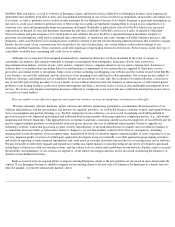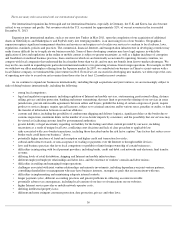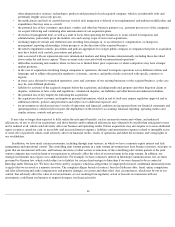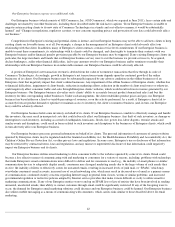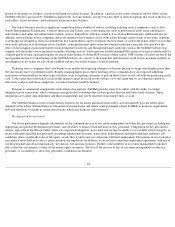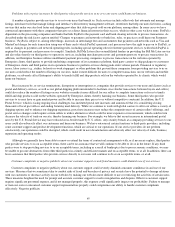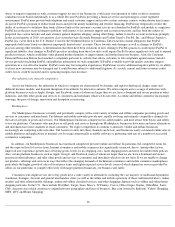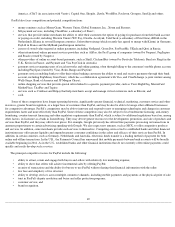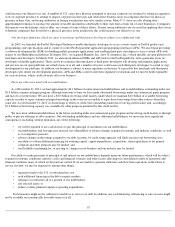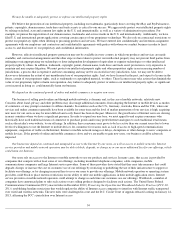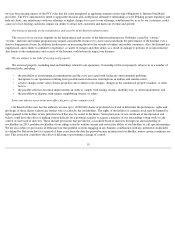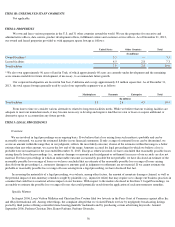eBay 2013 Annual Report Download - page 49
Download and view the complete annual report
Please find page 49 of the 2013 eBay annual report below. You can navigate through the pages in the report by either clicking on the pages listed below, or by using the keyword search tool below to find specific information within the annual report.
Network, among others. In addition, consumers have a large number of online and offline channels focused on one or more of the categories of
products offered on our site.
Consumers also can turn to many companies that offer a variety of services that provide other channels for buyers to find and buy items
from sellers of all sizes, including online aggregation and classifieds websites such as craigslist (in which we own a minority equity stake),
Oodle.com and a number of international websites operated by Schibsted ASA. Consumers also can turn to shopping-comparison sites, such as
Google Shopping and Bing Shopping. In certain markets, our fixed-price listing and traditional auction-style listing formats increasingly are
being challenged by other formats, such as classifieds.
Our classifieds websites, including Den Blå Avis, BilBasen, eBay Classifieds (including eBay Anuncios, eBay Kleinanzeigen and eBay
Annunci), Gumtree, Kijiji, LoQUo, Marktplaats.nl, mobile.de and alaMaula, offer classifieds listings in the U.S. and a variety of local
international markets. In many markets in which they operate, including in the U.S., our classified platforms compete against more established
online and offline classifieds platforms.
Our online shopping comparison websites (Shopping.com) compete with sites such as Google Shopping, Bing Shopping, Buy.com,
Nextag.com, Pricegrabber.com, Shopzilla, Buscapé in Latin America (owned by Naspers) and Yahoo! Product Search, which offer shopping
search engines that allow consumers to search the Internet for specified products. In addition, sellers are increasingly utilizing multiple sales
channels, including the acquisition of new customers by paying for search-related advertisements on horizontal search engine sites such as Bing,
Google, Yahoo!, Naver and Baidu. We use product search engines and paid search advertising to help users find our sites, but these services also
have the potential to divert users to other online shopping destinations. Consumers may choose to search for products and services with a
horizontal search engine instead of our sites, and horizontal search engines may send users to other shopping destinations instead of our sites.
Consumers and merchants who might use our sites to sell goods also have many alternatives, including general online ecommerce sites
such as Amazon, and more specialized sites, such as Etsy. Our international sites also compete for sellers with general online ecommerce sites
such as: Amazon, Rakuten.de, Quelle and Otto in Germany; Leboncoin.fr and PriceMinister (owned by Rakuten) in France; Taobao Marketplace
and Taobao Mall in China; Tradus (owned by Naspers) in Poland; Yahoo-
Kimo in Taiwan; Lotte, Naver and 11th Street in South Korea; Trading
Post, Quicksales in Australia; and Amazon and Play.com (owned by Rakuten) in the United Kingdom and other countries; and Alibaba and
AliExpress (owned by Alibaba) in Russia, Brazil and certain less developed markets. Our sellers may choose to sell their goods through other
channels, such as classifieds sites. Consumers and merchants also can create and sell through their own sites, and may choose to purchase online
advertising instead of using our services. In some countries, there are online sites that have larger customer bases and greater brand recognition
than we do, as well as competitors that may have a better understanding of local culture and commerce than we do. As our businesses in
developing countries grow, we increasingly may compete with domestic competitors that have advantages we do not possess, such as a greater
ability to operate under local regulatory authorities.
The principal competitive factors for Marketplaces include the following:
With respect to our online and mobile competition, additional competitive factors include:
We may be unable to compete successfully against current and future competitors. Some current and potential competitors have longer
operating histories, larger customer bases and greater brand recognition in other business and Internet sectors than we do. Other online
ecommerce sites may be acquired by, receive investments from, or enter into other commercial relationships with well-established and well-
financed companies. As a result, some of our competitors with other revenue
47
•
ability to attract, retain and engage buyers and sellers;
•
volume of transactions and price and selection of goods;
•
trust in the seller and the transaction;
•
customer service; and
•
brand recognition.
•
community cohesion, interaction and size;
• website or mobile platform and application ease-of-
use and accessibility;
•
user engagement;
•
system reliability;
•
reliability of delivery and payment;
•
level of service fees; and
•
quality of search tools.



